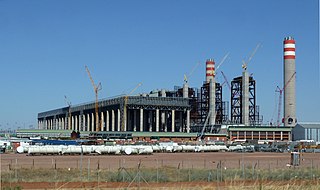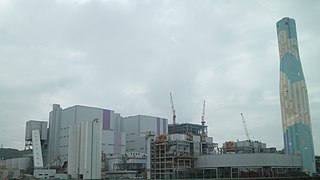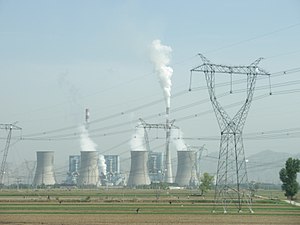
Many countries and territories have installed significant solar power capacity into their electrical grids to supplement or provide an alternative to conventional energy sources. Solar power plants use one of two technologies:

China is the world's leader in electricity production from renewable energy sources, with over triple the generation of the second-ranking country, the United States. China's renewable energy sector is growing faster than its fossil fuels and nuclear power capacity, and is expected to contribute 43 per cent of global renewable capacity growth. China's total renewable energy capacity exceeded 1,000 GW in 2021, accounting for 43.5 per cent of the country's total power generation capacity, 10.2 percentage points higher than in 2015. The country aims to have 80 per cent of its total energy mix come from non-fossil fuel sources by 2060, and achieve a combined 1,200 GW of solar and wind capacity by 2030. In 2023, it was reported that China was on track to reach 1,371 gigawatts of wind and solar by 2025, five years ahead of target due to new renewables installations breaking records.

China is the world leader in wind power generation, with the largest installed capacity of any nation and continued rapid growth in new wind facilities. With its large land mass and long coastline, China has exceptional wind power resources: Wind power remained China's third-largest source of electricity at the end of 2021, accounting for 7.5% of total power generation.

China is the largest market in the world for both photovoltaics and solar thermal energy. China's photovoltaic industry began by making panels for satellites, and transitioned to the manufacture of domestic panels in the late 1990s. After substantial government incentives were introduced in 2011, China's solar power market grew dramatically: the country became the world's leading installer of photovoltaics in 2013. China surpassed Germany as the world's largest producer of photovoltaic energy in 2015, and became the first country to have over 100 GW of total installed photovoltaic capacity in 2017.
The Baihetan Dam is a large hydroelectric dam on the Jinsha River, an upper stretch of the Yangtze River in Sichuan and Yunnan provinces, in southwest China. The dam is a 289-meter-tall double-curvature arch dam with a crest elevation of 827 m, and a width of 72 m at the base and 13 m at the crest. It is considered to be the last large hydropower project in China after a series of projects starting with the Three Gorges Dam. It is also the second largest hydropower plant in the world. The hydropower station is equipped with 16 hydro-generating units each having a capacity of 1 million kilowatts, the world's largest turbines. All hydro-generating units of the Baihetan hydropower station became fully operational on 20 December 2022.

China is the world's largest electricity producer, having overtaken the United States in 2011 after rapid growth since the early 1990s. In 2021, China produced 8.5 petawatt-hour (Pwh) of electricity, approximately 30% of the world's electricity production.

Medupi Power Station is a dry-cooled coal-fired power station built by Eskom near Lephalale in Limpopo province, South Africa. The station consists of 6 generating units with a nameplate capacity of 800 MW each bringing the total installed capacity of 4,800 MW.
Ultra-high-voltage electricity transmission has been used in China since 2009 to transmit both alternating current (AC) and direct current (DC) electricity over long distances separating China's energy resources and consumers. Expansion of both AC and DC capacity continues in order to match generation to consumption demands while minimizing transmission losses. Decarbonization improvements will result from the replacement of lower efficiency generation, located near the coast, by more modern high-efficiency generation with less pollution near the energy resources.

The Gansu Wind Farm Project or Jiuquan Wind Power Base is a group of large wind farms under construction in western Gansu province in China. The Gansu Wind Farm Project is located in desert areas near the city of Jiuquan in two localities of Guazhou County and also near Yumen City, in the northwest province of Gansu, which has an abundance of wind. In 2015 the complex was operating at below 40% utilization of the current 8 GW with a planned capacity of 20 GW. In 2017 the 2,383 km long Jiuquan - Hunan HVDC transmission line entered service connecting the remote complex to the Hunan regional grid allowing full utilization of its generation capacity. After 4 years of delays, the latest phase of construction was completed, bringing total generation capacity up to 10GW. Now, it is the world's largest wind power plant, having more than six times the capacity of the second largest,Jaisalmer Wind Park.
Wanakbori Thermal Power Station is a coal-fired power station in Gujarat, India. It is located on the bank of Mahi river in Kheda district. There are eight units at this location, seven of each 210 MW and one of 800 MW capacity.

Łagisza Power Station is a coal-fired thermal power station at Łagisza in Będzin, Poland. The power plant has a total installed power capacity of 1,060 MW and installed cogeneration thermal capacity of 335 MW. It is operated by Południowy Koncern Energetyczny, a subsidiary of the Tauron Group.
The Tuoketuo Power Station is the largest coal-fired power station in the world. The plant is located in Togtoh County, Hohhot, Inner Mongolia, China. The plant is estimated to have been one of the ten most carbon emitting coal-fired power plants in the world in 2018, at 29.46 million tons of carbon dioxide, and relative emissions are estimated at 1.45 kg per kWh. The plant was commissioned in November 1995 by the Tuoketuo Power Company, which currently owns and operates the power station.
Bihar State Power Holding Company Limited (BSPHCL), formerly Bihar State Electricity Board (BSEB) is a state-owned electricity regulation board operating within the state of Bihar in India. BSEB was established in 1958 as a statutory corporation under the Electricity (Supply) Act, 1948. As of November 2012, BSEB has nearly 1,700 officers and 14,850 employees. The derated capacity comes to just 530 MW. The BSEB was unbundled on 2 August 2011. Power Finance Corporation was the main consultant for BSEB's restructuring.

The Linkou Power Plant is a coal-fired power plant in Linkou District, New Taipei, Taiwan. With the previous total installed capacity of 600 MW, the power plant used to be the smallest coal-fired power plant in Taiwan. The power plant is currently undergoing retrofitting to increase its installed generation capacity to 2.4 GW.

The Talin Power Plant or Dalin Power Plant is a mix-generation power plant in Siaogang District, Kaohsiung, Taiwan.
Sagardighi Thermal Power Station is a thermal power plant located at Manigram, 13 km north of Sagardighi in the Indian state of West Bengal. The power plant is operated by the West Bengal Power Development Corporation Limited.
The Dongfang Power Station, also spelled Dongfang Power Plant, is a generating plant project in Hainan, located in Xiaozhou Industrial Development Zone, Dongfang City. It is the first supercritical coal-fired power plant in the history of Hainan Province.











